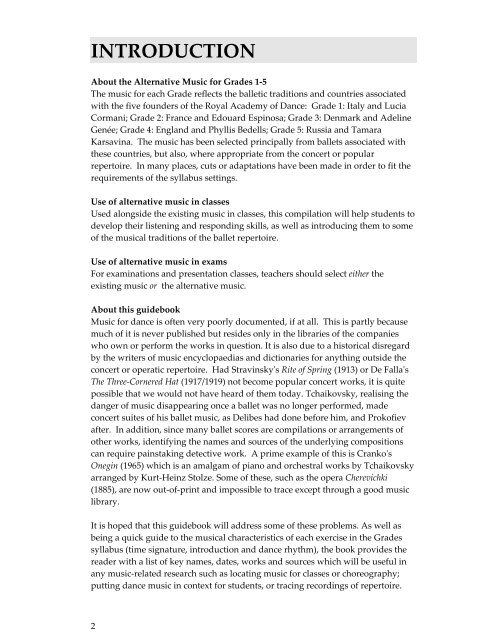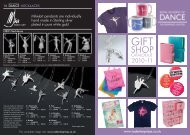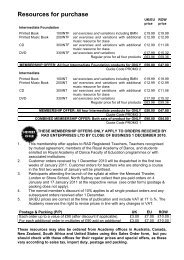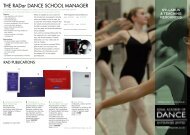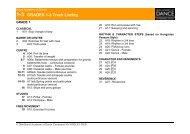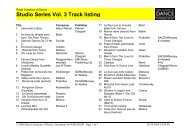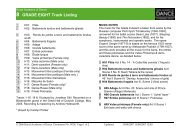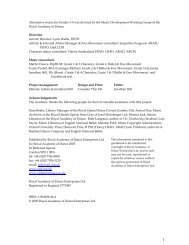Music in Focus guidebook to Alternative Music for Grades 1-3
Music in Focus guidebook to Alternative Music for Grades 1-3
Music in Focus guidebook to Alternative Music for Grades 1-3
You also want an ePaper? Increase the reach of your titles
YUMPU automatically turns print PDFs into web optimized ePapers that Google loves.
INTRODUCTION<br />
About the <strong>Alternative</strong> <strong>Music</strong> <strong>for</strong> <strong>Grades</strong> 1‐5<br />
The music <strong>for</strong> each Grade reflects the balletic traditions and countries associated<br />
with the five founders of the Royal Academy of Dance: Grade 1: Italy and Lucia<br />
Cormani; Grade 2: France and Edouard Esp<strong>in</strong>osa; Grade 3: Denmark and Adel<strong>in</strong>e<br />
Genée; Grade 4: England and Phyllis Bedells; Grade 5: Russia and Tamara<br />
Karsav<strong>in</strong>a. The music has been selected pr<strong>in</strong>cipally from ballets associated with<br />
these countries, but also, where appropriate from the concert or popular<br />
reper<strong>to</strong>ire. In many places, cuts or adaptations have been made <strong>in</strong> order <strong>to</strong> fit the<br />
requirements of the syllabus sett<strong>in</strong>gs.<br />
Use of alternative music <strong>in</strong> classes<br />
Used alongside the exist<strong>in</strong>g music <strong>in</strong> classes, this compilation will help students <strong>to</strong><br />
develop their listen<strong>in</strong>g and respond<strong>in</strong>g skills, as well as <strong>in</strong>troduc<strong>in</strong>g them <strong>to</strong> some<br />
of the musical traditions of the ballet reper<strong>to</strong>ire.<br />
Use of alternative music <strong>in</strong> exams<br />
For exam<strong>in</strong>ations and presentation classes, teachers should select either the<br />
exist<strong>in</strong>g music or the alternative music.<br />
About this <strong>guidebook</strong><br />
<strong>Music</strong> <strong>for</strong> dance is often very poorly documented, if at all. This is partly because<br />
much of it is never published but resides only <strong>in</strong> the libraries of the companies<br />
who own or per<strong>for</strong>m the works <strong>in</strong> question. It is also due <strong>to</strong> a his<strong>to</strong>rical disregard<br />
by the writers of music encyclopaedias and dictionaries <strong>for</strong> anyth<strong>in</strong>g outside the<br />
concert or operatic reper<strong>to</strong>ire. Had Strav<strong>in</strong>skyʹs Rite of Spr<strong>in</strong>g (1913) or De Fallaʹs<br />
The Three‐Cornered Hat (1917/1919) not become popular concert works, it is quite<br />
possible that we would not have heard of them <strong>to</strong>day. Tchaikovsky, realis<strong>in</strong>g the<br />
danger of music disappear<strong>in</strong>g once a ballet was no longer per<strong>for</strong>med, made<br />
concert suites of his ballet music, as Delibes had done be<strong>for</strong>e him, and Prokofiev<br />
after. In addition, s<strong>in</strong>ce many ballet scores are compilations or arrangements of<br />
other works, identify<strong>in</strong>g the names and sources of the underly<strong>in</strong>g compositions<br />
can require pa<strong>in</strong>stak<strong>in</strong>g detective work. A prime example of this is Crankoʹs<br />
Oneg<strong>in</strong> (1965) which is an amalgam of piano and orchestral works by Tchaikovsky<br />
arranged by Kurt‐He<strong>in</strong>z S<strong>to</strong>lze. Some of these, such as the opera Cherevichki<br />
(1885), are now out‐of‐pr<strong>in</strong>t and impossible <strong>to</strong> trace except through a good music<br />
library.<br />
It is hoped that this <strong>guidebook</strong> will address some of these problems. As well as<br />
be<strong>in</strong>g a quick guide <strong>to</strong> the musical characteristics of each exercise <strong>in</strong> the <strong>Grades</strong><br />
syllabus (time signature, <strong>in</strong>troduction and dance rhythm), the book provides the<br />
reader with a list of key names, dates, works and sources which will be useful <strong>in</strong><br />
any music‐related research such as locat<strong>in</strong>g music <strong>for</strong> classes or choreography;<br />
putt<strong>in</strong>g dance music <strong>in</strong> context <strong>for</strong> students, or trac<strong>in</strong>g record<strong>in</strong>gs of reper<strong>to</strong>ire.<br />
2


